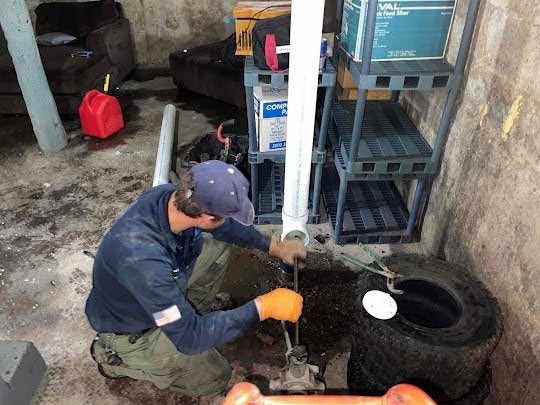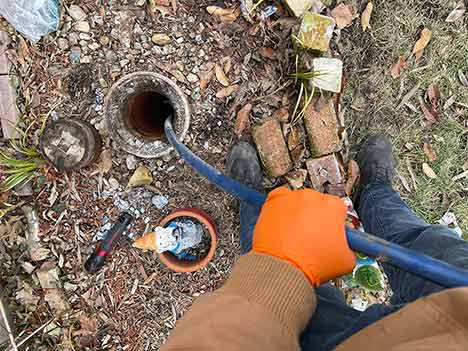
Sewer backups can be a homeowner’s worst nightmare, causing damage and posing health risks. A backup occurs when wastewater that is meant to flow into your main sewer line gets blocked or obstructed, causing it to overflow back into your home, typically at the lowest point such as the basement. There are several common causes of sewer backups, each of which can have significant repercussions if not addressed promptly and effectively.
A primary cause of sewer backups is root intrusion. Tree roots naturally seek out moisture, and if there are cracks or leaks in your sewer pipes, the roots can infiltrate and gradually expand, obstructing the flow. Another common cause is clogged pipes, which can occur when debris, grease, hair, and other foreign objects accumulate and form blockages. Additionally, sewer line collapses due to aging infrastructure or ground movements can also lead to backups. Heavy rainfall and flooding can overwhelm municipal sewer systems, contributing to backups in your home’s sewer line. Lastly, improper disposal of certain items, such as feminine hygiene products, paper towels, and wipes, can cause obstructions in your sewer pipes.
Common Signs of a Sewer Backup: What to Watch For
Being aware of the warning signs of a sewer backup can help you take swift action to mitigate damage and prevent more severe issues. One of the earliest indications is often gurgling sounds coming from your drains, toilets, or basement floor drains. These noises signal that air is trapped in the system due to a blockage. Slow drains in multiple fixtures can also indicate a blockage in the sewer line rather than isolated pipe issues.
Another telltale sign is sewage odors emanating from your drains or basement. The smell of raw sewage can be overpowering and is a clear indicator that something is amiss. During periods of heavy rain, if you notice water coming up through the basement floor drains or pooling around them, this can be a sign of a sewer backup as the municipal system becomes overwhelmed. Lastly, if you experience frequent toilet backups or wastewater rising in bathtub or floor drains, this is a strong indication that there is a blockage in the main sewer line.
Preventative Maintenance Strategies to Reduce the Risk of Sewer Backups
Preventative maintenance is essential in reducing the risk of sewer backups and protecting your basement from potential damage. One of the most effective strategies is to avoid flushing inappropriate items down your toilets and drains. These items include wipes, paper towels, feminine hygiene products, and grease, which can create blockages in the pipes. Educate your household on proper disposal methods to prevent these materials from entering your sewer system.
Regularly scheduling professional sewer line inspections and cleaning can help identify potential issues before they lead to backups. A professional plumber can use specialized equipment, such as cameras, to visually inspect the inside of your sewer lines, detecting cracks, root intrusions, and blockages. Hydro jetting, a high-pressure cleaning service, can then be used to clear any obstructions and maintain the optimal flow within your pipes.
Consider implementing routine checks and maintenance on your home’s gutters and downspouts to ensure proper drainage away from your foundation. Clear any debris and ensure that water is directed away from your home’s sewer line. Installing gutter guards can also help in preventing leaves and other debris from clogging the downspouts.
Installing a Backwater Valve: A Key Solution for Protecting Your Basement
By installing a backwater valve is an effective method for preventing sewer backups from entering your home. A backwater valve is a device installed on the main sewer line that allows wastewater to flow out of your home while preventing it from flowing back in. This valve is crucial, especially in areas prone to heavy rainfall or flooding, as it provides a protective barrier against municipal sewer backups.
The backwater valve has a flap that opens to allow wastewater to exit your home. When the municipal sewer system is overwhelmed, and there is backflow, the flap automatically closes, preventing the sewage from entering your basement. This device can be installed by a professional plumber and requires regular maintenance to ensure it remains functional. Checking the valve for debris and testing its operation periodically can help maintain its effectiveness.

Maintaining your sump pump is essential to ensure its reliability during heavy rain or flooding.
Sump Pumps: Essential Equipment for Basement Protection
Sump pumps are another crucial tool for protecting your basement from water damage and potential sewer backups. A sump pump is installed in a sump pit, typically at the lowest point of your basement. It functions by collecting and pumping out excess water that accumulates in the pit, thereby preventing it from seeping into your basement and causing damage.
There are two main types of sump pumps: submersible pumps and pedestal pumps. Submersible pumps are installed inside the sump pit and are designed to function while submerged in water. Pedestal pumps, on the other hand, have their motor above the pit and are not designed to get wet. Both types effectively remove excess water, but the choice between them depends on specific needs and preferences.
Maintaining your sump pump is essential to ensure its reliability during heavy rain or flooding. Testing the pump periodically, cleaning the sump pump, and ensuring the discharge line is clear of obstructions are crucial maintenance tasks. Additionally, consider installing a battery backup for your sump pump to ensure it continues to operate during power outages.
Professional Inspections and Regular Cleaning: Keeping Your Sewer Lines Clear
Professional inspections and regular cleaning of your home’s sewer lines are vital in maintaining a functional and efficient plumbing system. Hiring a licensed plumber to conduct routine inspections can help identify potential issues early on, allowing for timely repairs and preventing costly damage. Through the use of advanced tools such as camera inspections, a plumber can assess the condition of your sewer lines and pinpoint any blockages, cracks, or root intrusions that require attention.
Regular cleaning of your sewer lines is equally important in preventing backups. Hydro jetting is a highly effective method used by professionals to clear blockages and buildup from the inside of the pipes. This process involves using high-pressure water to blast away debris, grease, and roots, restoring the pipes to optimal condition. Scheduled hydro jet drain cleaning helps maintain a smooth flow within the sewer lines and minimizes the risk of clogs and backups.
Additionally, professional plumbers can provide valuable advice on maintaining your sewer system and recommend any upgrades or repairs needed to enhance its efficiency and reliability. By investing in expert inspections and cleaning services, you can safeguard your basement from potential sewer backup incidents.
Emergency Response and Cleanup: What to Do When a Sewer Backup Occurs
Despite taking preventative measures, sewer backups can still occur, and knowing how to respond in an emergency can significantly reduce damage and health risks. The first step is to avoid contact with the contaminated water, as it can contain harmful bacteria and pathogens. Evacuate the affected area and wear protective gear if you must enter the space to prevent exposure.
Next, immediately stop using water in your home to minimize further backups. Turn off the water supply and avoid flushing toilets or running faucets. Contact a professional plumber or basement sewage cleanup service to assess the situation and provide necessary repairs and cleanup.
Documenting the damage with photographs and notes is essential for insurance purposes. Notify your insurance company as soon as possible to initiate the claims process. Professional cleanup services can then safely remove contaminated water, sanitize affected areas, and repair any structural damage. Prompt and thorough cleaning helps prevent mold growth and restores your basement to a safe and habitable condition.
Insurance Considerations and Coverage for Sewer Backups
Understanding your insurance coverage for sewer backups is crucial in mitigating the financial impact of such incidents. Standard homeowner’s insurance policies typically do not include coverage for sewer backups. However, many insurers offer optional endorsements or riders that can be added to your policy to provide this coverage.
Review your insurance policy to determine if you have sewer backup coverage and the extent of that coverage. This endorsement typically covers the costs of cleanup, repairs, and replacement of damaged property resulting from a sewer backup. Be aware of any policy limits, deductibles, and exclusions that may apply.
Additionally, maintaining documentation of regular maintenance, inspections, and preventative measures can support your insurance claims and demonstrate that you have taken proactive steps to prevent sewer backups. This documentation can be valuable in expediting the claims process and ensuring you receive the necessary compensation for damages incurred.
Long Term Planning and Investment in Sewer Backup Prevention
Investing in long term planning and preventative measures is essential for safeguarding your home against sewer backups. One of the most effective strategies is to upgrade your plumbing system and replace aging pipes with more durable and modern materials. Older pipes are more prone to cracks and root intrusions, making them a common cause of sewer backups.
Consider installing a combination of protective devices, such as backwater valves, sump pumps, and check valves, to create a comprehensive defense system against backups. These devices work together to prevent sewage from entering your home and manage excess water during heavy rainfall or flooding.
Implementing an ongoing maintenance schedule that includes regular inspections, drain cleaning services, and upgrades can significantly reduce the risk of backups. Collaborating with a professional plumbing service to develop a customized maintenance plan ensures that your sewer system remains in optimal condition and minimizes the likelihood of costly and disruptive incidents.
Additionally, staying informed about local municipal plans and improvements to the public sewer system can help you anticipate potential issues and take preventive action. By investing time, effort, and resources into long-term planning and preventative measures, you can protect your home and maintain a safe and comfortable living environment.
Creating a Safe and Comfortable Living Environment
Protecting your basement from sewer backups is crucial in maintaining a safe and comfortable living environment for you and your family. By understanding the causes of sewer backups, recognizing the warning signs, and implementing preventative strategies, you can significantly reduce the risk and impact of these incidents.
Investing in essential equipment, such as backwater valves and sump pumps, along with professional inspections, regular cleaning, and maintenance, creates a robust defense system against sewer backups. Additionally, being prepared with an emergency response plan and understanding your insurance coverage ensures that you can swiftly and effectively address any issues that arise.
Ultimately, creating a safe and comfortable living environment involves a proactive approach to home maintenance and prevention. By taking these steps, you can protect your basement, preserve the integrity of your home, and enjoy peace of mind knowing that you have taken the necessary measures to safeguard your living space from sewer backups.

